By Rabee Aissa and Hussein Rikaby (MSA archaeologists)
Our colleague Hanan Mahmoud, archaeologist in the Giza pyramids zone and AERA team member wrote a blog three weeks ago under the title ‘Fighting for Archaeology – the Silo Building Complex’. She talked about the 2011 AERA season when the mission exposed the Silo Building Complex for the first time. Then she mentioned that there was big ‘fighting’ between her and us (Rabee and Hussein) about who will excavate this area. But in the 2012 season, it was Hussien and I who excavated the Silo Building, with four Giza pyramids archaeologists who trained in the AERA archaeological field-school as students. Then this season Hanan excavated for one month, in March, the southern part of sondage 183 in room 11,237 where a sequence of 5th dynasty silos is located.
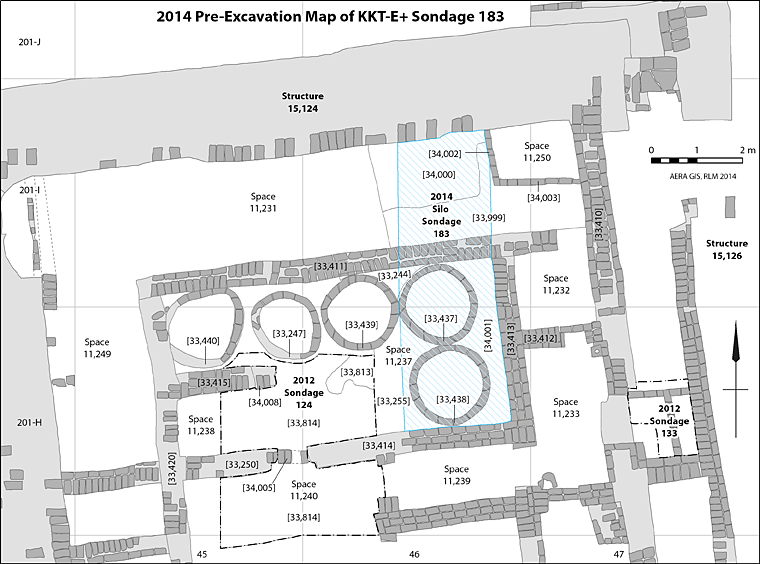 Plan of the Silo Building Complex, showing the location of sondage 183. Within the sondage the southern space 11237 was excavated by Hanan Mahmoud and the northern space 11231 is being excavated by Rabee Aissa and Hussein Rikaby. Plan from AERA’s GIS produced by Rebekah Miracle.
Plan of the Silo Building Complex, showing the location of sondage 183. Within the sondage the southern space 11237 was excavated by Hanan Mahmoud and the northern space 11231 is being excavated by Rabee Aissa and Hussein Rikaby. Plan from AERA’s GIS produced by Rebekah Miracle.
Actually, she did a great job. She discovered some inscribed mud sealings with names and royal titles of the 5th dynasty Kings, such as ‘Raneferef,’ ‘Menkauhor’ and ‘Niuserra.’ Also she managed to solve some problems related to the stratigraphic relations between the various mud brick walls. Hussien and I arrived from Upper Egypt to join the mission on the 1st of April. We concentrated our excavation in the northern part of sondage 183, between the northern mud brick enclosure wall and the northern boundary of the silos’ room.
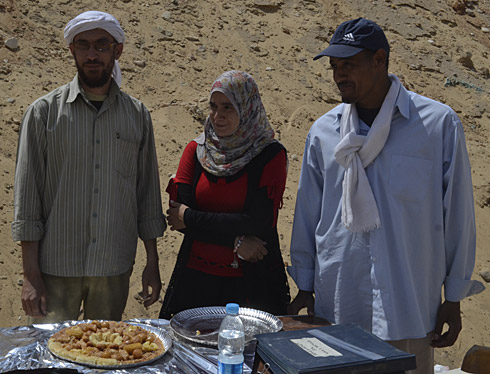 Sweets that brought us good luck. Hanan welcomes back to Giza Rabea and Hussein. Photo by Daniel Jones.
Sweets that brought us good luck. Hanan welcomes back to Giza Rabea and Hussein. Photo by Daniel Jones.
On 7th of April Hanan visited us on the site to say hello and welcome us back to Giza. She was very kind and hospitable as usual. She brought with her a packet of oriental sweets. After eating the sweets she insisted on helping us in the excavation that day. And we were very lucky that day because we exposed a sequence of archaeological features, strongly indicating a structure earlier than the Silo Building Complex!
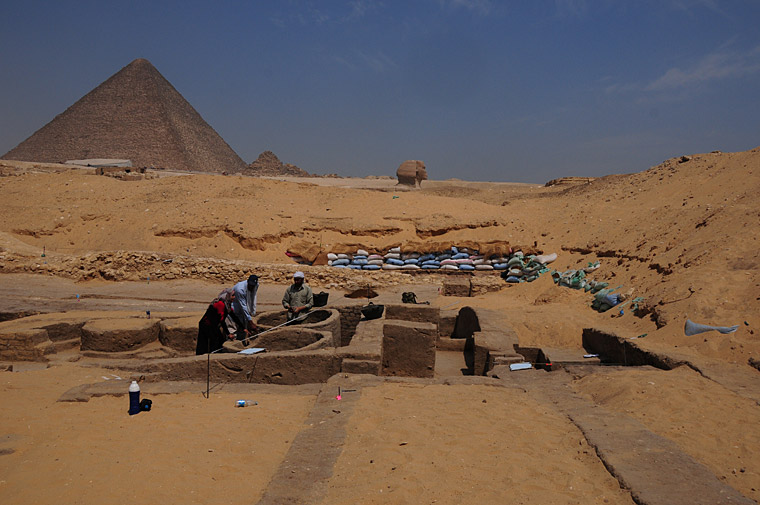 Working in the Silo Building Complex. View to the north, photo by Mohsen Kamel.
Working in the Silo Building Complex. View to the north, photo by Mohsen Kamel.
The first visible feature of the new discovered early building, under the silos, is a mud brick wall coated on both faces with a layer of yellow marl plaster. This early wall goes under the marl-brick wall, which forms the northern boundary of the silos’ room. The visible length of this older wall is about 1.24 m while the visible width is about 0.48 m. Our oldest wall divides the excavation area into two rooms. Each room is occupied with remains of a very fine Nile silt floor. The eastern room appears to be a baking area similar to the bakeries excavated in the Heit el-Ghurab site such as, the ‘EOG-D bakery’ and the ‘1991 bakeries‘. It contains in its southern and northern ends a dense dark ash deposit that fills a shallow, rectangular channel or cut. It suggests that the bases of these two rectangular areas could be a baking installation with a sequence of depressions from ceramic bread molds similar to those discovered in the bakeries elsewhere on site.
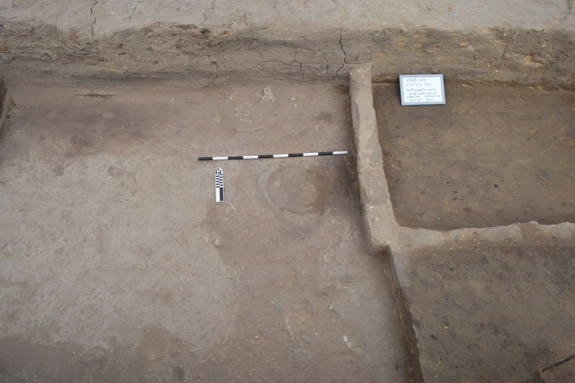 Excavations in the northern part of sondage 183 in the Silo Building Complex. The circular feature – possibly a vat emplacement – and the wall indicating an early building beneath the Silo Building Complex.
Excavations in the northern part of sondage 183 in the Silo Building Complex. The circular feature – possibly a vat emplacement – and the wall indicating an early building beneath the Silo Building Complex.
View to the north, photo by Rabee Aissa.
One of the most interesting features in this early structure is a rounded Nile clay, very smooth, surface filled with an ashy silt deposit. This rounded installation measured approximately 0.42 in diameter. We suggested that it was a vat impression. Also we exposed a concentration of rough limestone blocks within a layer of sandy silt. These limestone blocks supported the idea that this room could be a baking area as the limestone elements indicate the remains of a hearth platform similar to others discovered by the AERA mission in many bakeries at Heit el-Ghurab.
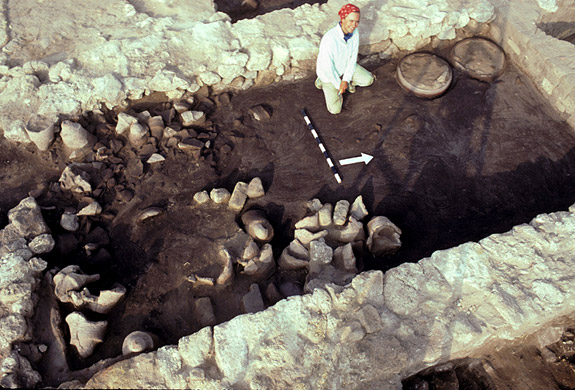 A bakery in the Heit el-Ghurab settlement, excavated by Anne Foster in 1991.
A bakery in the Heit el-Ghurab settlement, excavated by Anne Foster in 1991.
View to the west, photo by Mark Lehner.
At the same time, we discovered a broken limestone cylinder sealing. This important sealing, inscribed with some hieroglyphic sighs, included a part of an ancient Egyptian cartouche. The brake in this sealing shows the suspension hole through the length of the sealing.
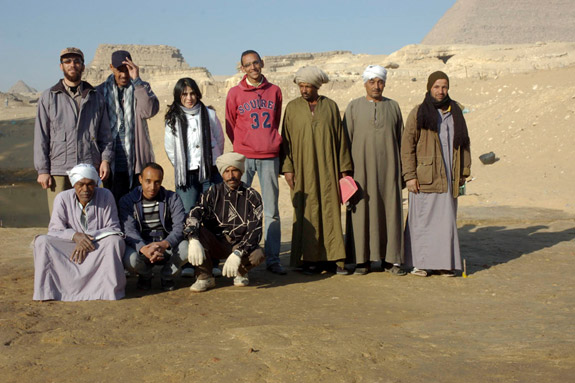 The Silo Bulding complex team in 2012. View to the west, photo by Yasser Mahmoud.
The Silo Bulding complex team in 2012. View to the west, photo by Yasser Mahmoud.
Finally, the excavation time is a very important part of the life of field archaeologists. This excavation time will not be a good time without the presence of your real friends – to share with each other every good thing. Thank you Hanan, you are welcome to share with us the excavation in the Silo Building Complex next season (Insha’Allah) but…only after bringing us sweet every week!
